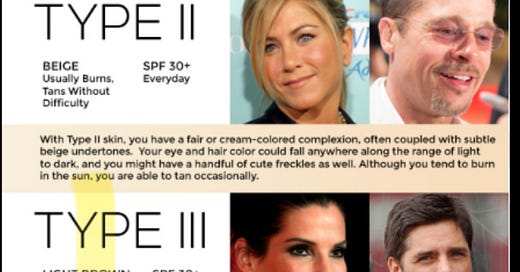The case for getting some sunlight
And how "reducing the risk of skin cancer at all costs" does indeed come with a price.
I'm gonna soak up the sun
While it's still free
I'm gonna soak up the sun
Before it goes out on me
~lyrics by Sheryl CrowThis was a really difficult post to write. Intuitively we sense that getting some sun might be good, but dermatologists and beauty experts the world over tell us that “there is no safe way to tan.” Ultraviolet light can cause skin cancer, but very few healthy, thriving people live in dark caves. There is no one-size-fits-all recommendation about sun exposure, either. We have different skin types, latitudes, altitudes, seasons, and medical considerations. But I’m going to take a walk in the minefield anyway, as there is a fascinating trend right now that acknowledges we are probably causing some harm by fastidiously avoiding the sun in our quest for youthful skin and skin cancer risk reduction. How much sun should we get, and why? Honestly, it’s a personal risk/reward calculation, and the absolute evidence is just not there yet.
But increasingly I agree that the answer cannot be zero. And even Australia, with the highest skin cancer rates in the world, has been leading the way back into the light for brief exposures.
For decades, we've been told to avoid sun exposure and constantly slather on sunscreen to protect ourselves from skin cancer. But new research suggests this advice, when taken to the dermatologic extreme, may be doing some harm along with some benefit. While excessive sun exposure does increase skin cancer risk, wrinkles, cataract formation and macular degeneration, some degree of sunlight appears to have numerous health benefits that we've been neglecting to acknowledge as part of a tradeoff. The mechanisms are novel, fascinating, and still being discovered.
The following post was also informed by a podcast I listened to in which Rowan Jacobsen, a science journalist who spent years investigating the health impacts of sunlight, broke down his findings as gleaned from years of research and reporting. It also pulls from articles he has written on this subject in The Atlantic and Outside Magazine, plus a sunburst of other linked sources, journals, and expert guidelines. Give yourself 10 minutes to read it, preferably in the late morning or afternoon sun.
Keep reading with a 7-day free trial
Subscribe to Examined to keep reading this post and get 7 days of free access to the full post archives.




